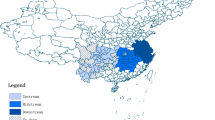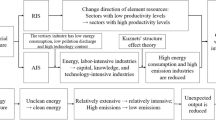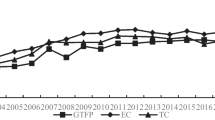Abstract
The entropy method is used to calculate pollution comprehensive index reflecting provincial environmental pollution level. On this basis, the Malmquist productivity index is used to study the regional green total factor productivity (GTFP) in China, and the system generalized moment method is used to explore the influencing factors of GTFP. Firstly, the results show that the provinces with lower environmental pollution comprehensive index are mainly in the western and eastern regions, while the provinces with higher pollution comprehensive index are mainly distributed in the central inland areas. Secondly, GTFP shows an N-type upward trend, which is basically consistent with the trend of total factor productivity. The overall GTFP in the east is on the rise, which is promoted by technical efficiency. The GTFP in the central and west has declined, and the main factor restricting their improvement is technological retrogression. The expansion of production scale in the east and west can contribute to the improvement of GTFP. The central region is at a stage where the scale of returns is not economic, and it is more important for promoting technological progress. Lastly, the industrial structure can significantly inhibit the increase of GTFP, however, the energy consumption structure, FDI and pollution control investment have a significant role in improving GTFP.







Similar content being viewed by others
Explore related subjects
Discover the latest articles, news and stories from top researchers in related subjects.References
Bond SR (2002) Dynamic panel data models: a guide to micro data methods and practice. Port Econ J 1(2):141–162
Caves DW, Christensen LR, Diewert WE (1982) The economic theory of index numbers and the measurement of input, output and productivity. Econ J Econ Soc 50(6):1393–1414
Fare R, Grosskopf S, Lindgren B et al (1992) Productivity changes in Swedish pharmacies 1980–1989: a non-parametric Malmquist approach. J Product Anal 3(1):81–97
Golove WH, Schipper LJ (1997) Restraining carbon emissions: measuring energy use and efficiency in the USA. Energy Policy 25(7):803–812
Halkos GE, Tzeremes NG (2013) Economic growth and environmental efficiency: evidence from US regions. Econ Lett 120(1):48–52
Han BL, Ouyang ZY, Wang WJ (2018) The relationship between regional industrial organizing levels and ecological economic efficiency. J Clean Prod 171:857–866
Iftikhar Y, He WJ, Wang ZH (2016) Energy and CO2 emissions efficiency of major economies: a non-parametric analysis. J Clean Prod 139:779–787
Kumar S (2006) Environmentally sensitive productivity growth: a global analysis using Malmquist–Luenberger index. Ecol Econ 56(2):280–293
Liao H, Du YF, Huang ZM et al (2016) Measuring energy economic efficiency: a mathematical programming approach. Appl Energy 179:479–487
Malmquist S (1953) Index numbers and indifference surfaces. Trabajos de Estadistica 4(2):209–242
Ren WH, Ji JY, Chen L et al (2018) Evaluation of China’s marine economic efficiency under environmental constraints-an empirical analysis of China’s eleven coastal regions. J Clean Prod 184:806–814
Song ML, Wang SH (2014) DEA decomposition of China’s environmental efficiency based on search algorithm. Appl Math Comput 247:562–572
Tang QS, Guo XW, Sun Y et al (2007) Ecological conversion efficiency and its influencers in twelve species of fish in the Yellow Sea Ecosystem. J Mar Syst 67(3–4):282–291
Tao XP, Wang P, Zhu BZ (2016) Provincial green economic efficiency of China: a non-separable input–output SBM approach. Appl Energy 171:58–66
Wang K, Wei YM (2014) China’s regional industrial energy efficiency and carbon emissions abatement costs. Appl Energy 130(1):617–631
Wapner P (2011) Civil society and the emergent green economy. Rev Policy Res 28(5):525–530
Woodward RT, Bishop RC (1995) Efficiency, sustainability and global warming. Ecol Econ 14(2):101–111
Xie HL, Chen QR, Wang W et al (2018) Analyzing the green efficiency of arable land use in China. Technol Forecast Soc Change 133:15–28
Yao X, Zhou HC, Zhang AZ et al (2015) Regional energy efficiency, carbon emission performance and technology gaps in China: a meta-frontier non-radial directional distance function analysis. Energy Policy 84:142–154
Author information
Authors and Affiliations
Corresponding author
Additional information
Publisher's Note
Springer Nature remains neutral with regard to jurisdictional claims in published maps and institutional affiliations.
Rights and permissions
About this article
Cite this article
Ren, Y. Research on the green total factor productivity and its influencing factors based on system GMM model. J Ambient Intell Human Comput 11, 3497–3508 (2020). https://doi.org/10.1007/s12652-019-01472-2
Received:
Accepted:
Published:
Issue Date:
DOI: https://doi.org/10.1007/s12652-019-01472-2




